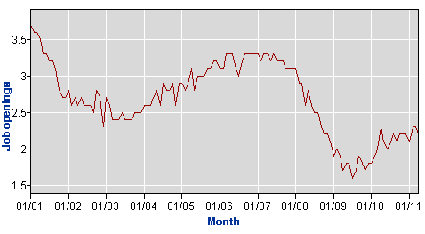June 20, 2011
Robert Samuelson devoted his column today to the problem of structural unemployment. He tells us that many positions are going unfilled, in spite of the high rate of unemployment. In fact, according to the Bureau of Labor Statistics, the job opening rate is just 2.2 percent.

Source: Bureau of Labor Statistics.
Since there will always be some time involved in replacing new workers, this rate can never fall to zero. If the rate were to fall to 1.7 percent, its low for this downturn, this would imply that another 650,000 of the 14 million unemployed would have jobs. It is also worth noting that it would be reasonable to expect that employers would be more choosy about their hires, therefore taking longer, in a period in which they face weak demand (and therefore have little urgency for new workers) and have many good workers to choose from.
In a context where the economy is strong and relatively few people are looking for work, employers would be expected to try to hire quickly since there will be little benefit to waiting for a better job candidate. However, in the current labor market, there is a strong likelihood that an employer can find a better candidate if they wait longer to hire. This fact would be expected to raise the number of job openings even if there is no reduction in the quality of the workforce.
It is also important to note that if there really is a serious problem of structural unemployment (firms are unable to find qualified workers for vacant positions) then there should be substantial sectors of the economy where wages are rising rapidly. It is difficult to identify any major sector where this is the case. Wages for workers at all education levels are at best just keeping pace with the rate of inflation.
This implies that if employers are really having trouble finding qualified workers then it is likely because they are offering wages that are below the market rate. The problem then is a lack of qualified employers, not a lack of qualified workers.







Comments